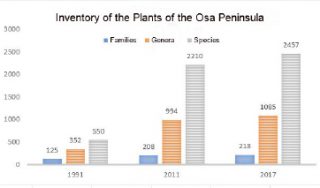Reinaldo Aguilar, A Friend of the Plants of Costa Rica’s Osa Peninsula
Posted in Interesting Plant Stories on November 13, 2017 by Scott Mori
Scott A. Mori, Ph.D., is a Curator Emeritus at The New York Botanical Garden. He is a specialist in the Brazil nut family.

In August, renowned botanist Reinaldo Aguilar was honored for his ongoing inventory of the plants of the Osa Peninsula, which juts into the Pacific Ocean in southwestern Costa Rica near the Panama
border. In a ceremony at Corcovado National Park on the peninsula, Costa Rican President Luis Guillermo Solís presented Reinaldo with an award and pointed out how important botanical inventories are for selecting and managing biological preserves on the Osa, a region of high biodiversity.
Reinaldo began documenting plant diversity on the Osa in 1991 and continues to explore for new and interesting plants. Since 2008, Reinaldo has been collaborating with the William and Lynda Steere Herbarium of The New York Botanical Garden and is the lead author of the Vascular Plants of the Osa Peninsula.

During the 15 years that he lived on the peninsula, he has collected over 7,000 specimens. Because the process of drying samples for herbarium specimens may compromise the color and structure of the specimens, Reinaldo takes digital photographs before the collections are dried in order to make them more informative. Thanks to his long experience, Reinaldo knows what parts of the plant are important to be photographed before drying. For example, most species of the Brazil nut family (Lecythidaceae) have fleshy flowers, so Reinaldo photographs flower features that would otherwise be lost in the drying of specimens.
The documentation of the plants of the Osa requires a great deal of work. First Reinaldo collects the specimen, sometimes from canopy trees as tall as 115 feet. He then assigns the specimen a sequential number in his collection series (e.g., his next collection will be Aguilar 16593). He writes notes about the plant in his field notebook, places his name and collection number on a folded page of newspaper, places the sample between the folded newspaper page, dries the specimen in a drying press, transfers the information from his notebook to his database, and generates labels from the database. The specimen and label are then glued onto herbarium sheets, which are stamped with a barcode and scanned. Other material, such as flowers and fruits preserved in alcohol and photographic images, are vouchered by his collection numbers. The vouchers are important because if there is doubt about the correct name of a collection, the herbarium voucher can be consulted to confirm or reject the name. If an image is not vouchered by a plant specimen, it may not be possible to figure out the correct name of the plant collected.

By the end of 1991, Reinaldo and his colleagues had inventoried 550 species on the Osa Peninsula. Today, there are approximately 4.5 times that number. As part of that effort, 75,000 images are archived on his Flickr pages. This is a major task considering the work it takes to manage the images and the time needed to identify the plants he collects, which involves comparing them with identified specimens in herbaria, enlisting the aid of specialists, and using both digital and printed botanical literature.

One of Reinaldo’s important accomplishments has been his role in discovering and publishing 15 new species of shrubs and trees (listed below). To honor Reinaldo’s contribution to the knowledge of the plants of the Osa, other botanists have named new species for him, such as Eschweilera aguilarii in the Lecythidaceae family and Guatteria reinaldoi in the Annonaceae family.

As other Central American forests on the Pacific continue to be deforested, the Osa Peninsula has benefited from a long established national park system dedicated to protecting Costa Rican biodiversity, an active conservation community, and citizens who know the importance of protecting Costa Rica’s flora and fauna. Reinaldo Aguilar merits recognition for his contributions to the inventory of the flora of his country and especially for his ongoing efforts to document the plants of the Osa Peninsula. Congratulations, Reinaldo!
New species discovered and published by Reinaldo Aguilar: Chrysophyllum moralesianum, C. sierpense (Sapotaceae), Couepia osaensis (Chrysobalanaceae), Dacryodes talamancensis (Burseraceae), Laetia povedae (Salicaceae), Miconia osaensis (Melastomataceae), Myrcia paulii-jonesii, M. riverae (Myrtaceae); Pentagonia gambagam, P. osapinnata (Rubiaceae), Pleodendron costaricense (Canellaceae), Sloanea damonsmithii, S. eugenifloresiae, S. herrerae (Elaeocarpaceae), and Tapirira lepidota (Anacardiaceae)

